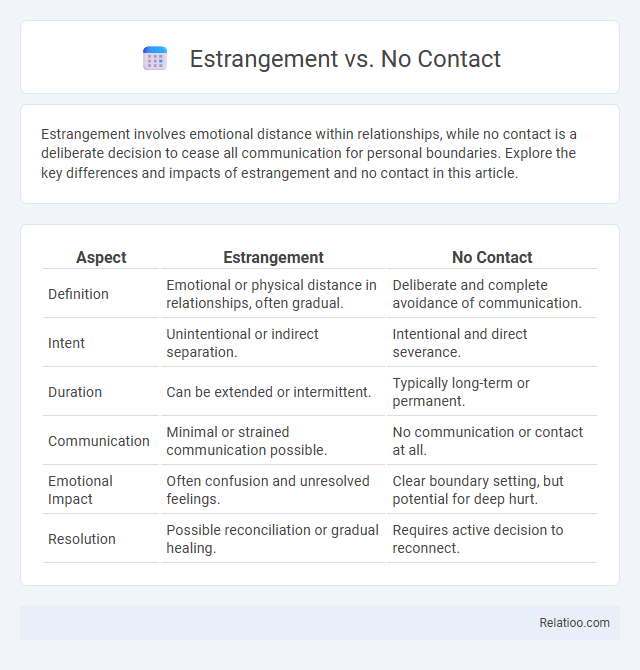Estrangement involves emotional distance within relationships, while no contact is a deliberate decision to cease all communication for personal boundaries. Explore the key differences and impacts of estrangement and no contact in this article.
Table of Comparison
| Aspect | Estrangement | No Contact |
|---|---|---|
| Definition | Emotional or physical distance in relationships, often gradual. | Deliberate and complete avoidance of communication. |
| Intent | Unintentional or indirect separation. | Intentional and direct severance. |
| Duration | Can be extended or intermittent. | Typically long-term or permanent. |
| Communication | Minimal or strained communication possible. | No communication or contact at all. |
| Emotional Impact | Often confusion and unresolved feelings. | Clear boundary setting, but potential for deep hurt. |
| Resolution | Possible reconciliation or gradual healing. | Requires active decision to reconnect. |
Understanding Estrangement: Definition and Scope
Estrangement refers to the breakdown of a once-close relationship, often involving emotional distance and lack of communication, while no contact is a deliberate decision to cease all communication for personal boundaries or healing. Understanding estrangement involves recognizing its complexity, encompassing gradual alienation or sudden rifts that may not always result in complete no contact. Your awareness of these distinctions helps navigate family conflicts with clearer expectations and emotional insight.
What is No Contact? Key Differences
No Contact is a deliberate and complete cessation of communication between parties, often used as a boundary-setting strategy to protect mental health during conflicts or estrangement. Unlike estrangement, which can occur organically due to unresolved issues or emotional distance, No Contact is an intentional choice to avoid interaction entirely. The key difference lies in No Contact's proactive element, emphasizing zero communication, whereas estrangement may involve limited or sporadic contact based on circumstances.
Common Causes Leading to Estrangement
Common causes leading to estrangement include unresolved conflicts, betrayals such as infidelity or dishonesty, and significant differences in values or lifestyles that create ongoing tension. No contact is often a deliberate response to repeated emotional or physical harm, boundary violations, or toxic behavior that individuals find unbearable. Estrangement can arise from cumulative negative experiences where communication breaks down, leading individuals to distance themselves for emotional protection and mental well-being.
No Contact as a Deliberate Strategy
No Contact as a deliberate strategy involves intentionally ceasing all communication with a person, often to protect emotional well-being and establish clear boundaries. Unlike estrangement, which can be a passive or unintentional drift in relationships, No Contact requires conscious decision-making and consistent enforcement for personal healing or safety. This method is commonly used in cases of toxic family dynamics, abusive relationships, and situations where ongoing interaction causes psychological harm.
Emotional Impact of Estrangement vs No Contact
Estrangement often involves feelings of deep emotional pain, loss, and unresolved conflict, leading to significant stress and grief for you. In contrast, no contact is a conscious decision to cut ties that can provide emotional relief, boundaries, and space to heal from toxic relationships. While both result in separation, estrangement carries a heavier emotional toll due to underlying tensions, whereas no contact promotes personal well-being through intentional disconnection.
Communication Patterns: Limited vs Zero Interaction
Estrangement involves limited interaction where communication occurs sporadically or under controlled circumstances, allowing some connection despite emotional distance. No contact represents zero interaction, with complete cessation of communication to establish firm boundaries and emotional separation. The key distinction lies in communication patterns: estrangement permits restricted dialogue, whereas no contact enforces total silence.
Family Dynamics in Estrangement and No Contact
Family dynamics in estrangement often involve complex emotional distance, unresolved conflicts, and partial communication breakdowns, whereas no contact represents a deliberate and complete severance of interaction to protect your mental well-being. Estrangement may still allow occasional interactions or mediation, reflecting a fluctuating state of familial relationships influenced by underlying tensions. Understanding these distinctions helps you navigate the nuances of family dynamics when emotional safety and boundaries are paramount.
Reconciliation Possibilities: Bridges and Barriers
Reconciliation possibilities vary significantly between estrangement, no contact, and estrangement with communication, with the latter offering the most bridge for dialogue and eventual healing. Estrangement without communication creates barriers due to unresolved conflicts and emotional distance, making reconciliation more challenging. Your ability to rebuild relationships depends on the willingness of both parties to forgive, establish trust, and engage in open, respectful communication.
Psychological Recovery and Coping Mechanisms
Estrangement, no contact, and reconciliation represent distinct relationship dynamics that influence your psychological recovery and coping mechanisms. Estrangement often involves ongoing emotional turmoil and requires strategies like therapy and boundary-setting for healing, while no contact emphasizes complete disengagement to foster emotional detachment and self-care. Reconciliation demands rebuilding trust and communication skills, enabling adaptive coping and gradual psychological restoration.
Seeking Support: Therapy and Community Resources
Seeking support during estrangement, no contact, or general relational estrangement is crucial for maintaining your mental health and emotional well-being. Therapy offers personalized strategies to navigate complex feelings, rebuild boundaries, and foster resilience, while community resources such as support groups provide shared experiences and validation from those who understand your situation. Engaging with professionals and peers reduces isolation and empowers you with tools to manage the ongoing challenges of estrangement.

Infographic: Estrangement vs No Contact
 relatioo.com
relatioo.com